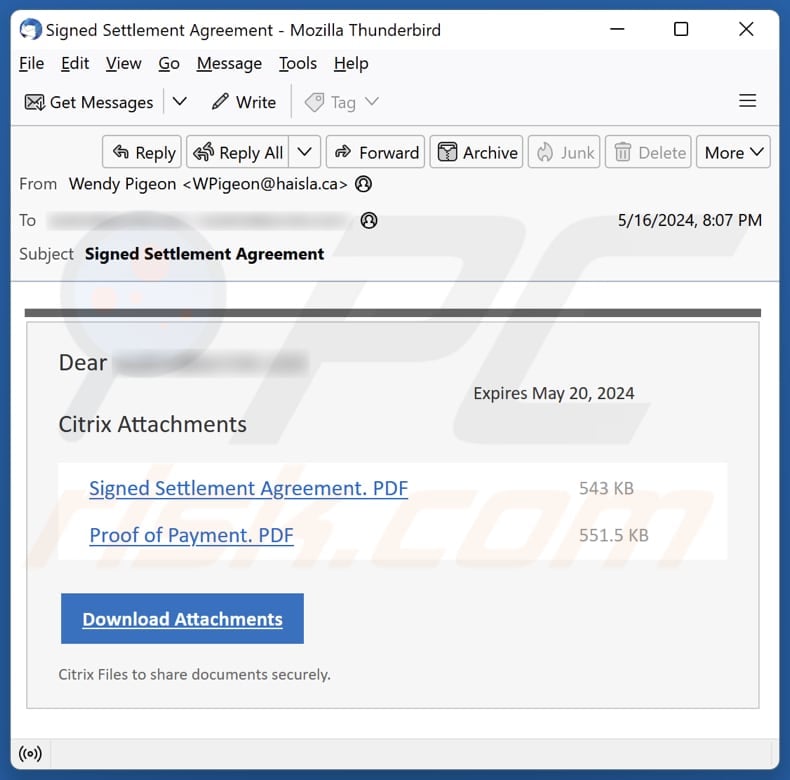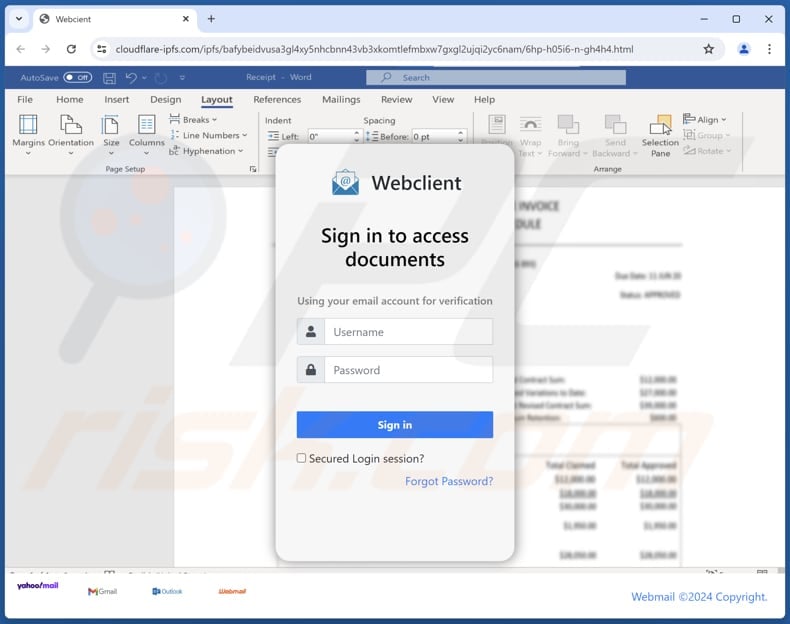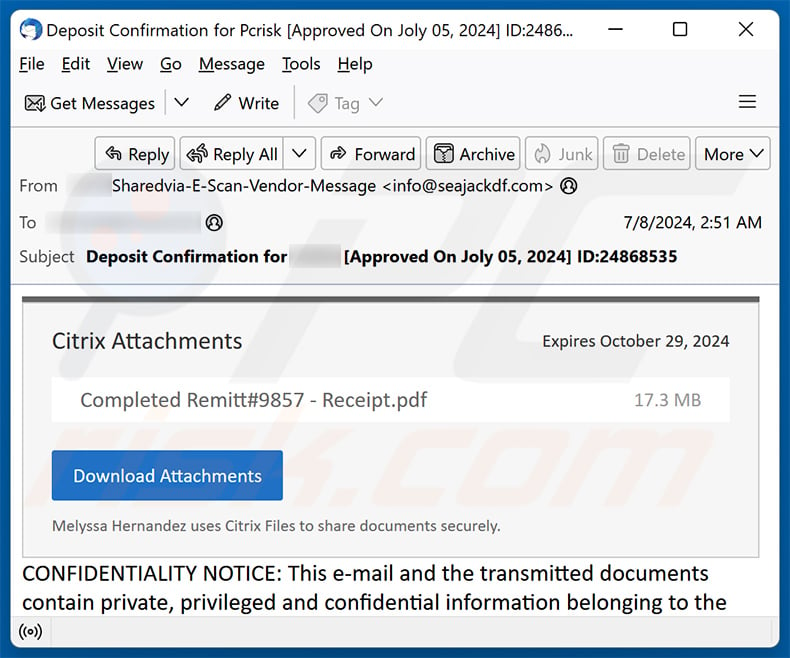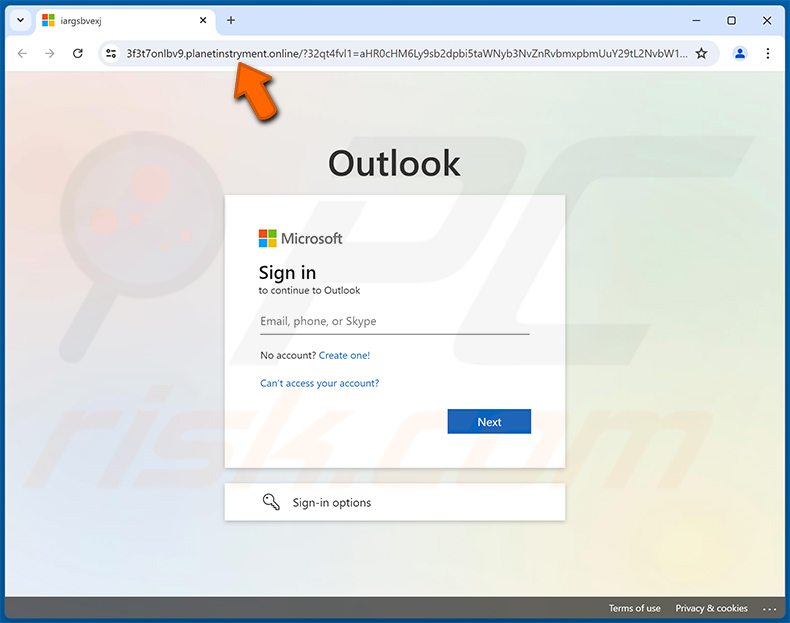How to spot scams like "Citrix Attachments" phishing scam
Phishing/ScamAlso Known As: Citrix Attachments phishing email
Get free scan and check if your device is infected.
Remove it nowTo use full-featured product, you have to purchase a license for Combo Cleaner. Seven days free trial available. Combo Cleaner is owned and operated by RCS LT, the parent company of PCRisk.com.
What is the "Citrix Attachments" email scam?
During our examination of the email, we noticed characteristics of a phishing attempt. This email is a fraudulent letter disguised as a notification regarding a signed settlement agreement. Scammers use it to trick unsuspecting recipients into opening a fake website designed to steal personal information.

More about the "Citrix Attachments" phishing campaign
This phishing email pretends to be a signed settlement agreement, claiming to have attachments related to legal matters hosted by Citrix. It states that these attachments will expire on the specified data and encourages the recipient to download them.
However, recipients should exercise caution as this phishing email aims to trick them into opening a fake website. The links in this email (document names and the "Download Attachments" button) are designed to open a phishing page. This page requests users to enter a username and password to access documents and has a blurred image of the supposed document in the background.
It is evident that this phishing website is created to steal email account login credentials. Wit this information, scammers can access personal and sensitive information stored within the email account, including conversations, contacts, and attachments, which can be used for further scams or fraud.
Also, scammers can use the compromised email account to send phishing emails to contacts, attempting to trick them into divulging sensitive information or clicking on malicious links. Moreover, they may try to access other accounts (e.g., social media or gaming accounts) using the stolen login credentials.
Thus, it is strongly recommended to examine emails and websites before providing sensitive information to avoid identity theft, financial loss, and other issues.
| Name | Citrix Attachments Email Scam |
| Threat Type | Phishing, Scam, Social Engineering, Fraud |
| Fake Claim | The recipient has received two documents |
| Disguise | A notification regarding a signed settlement agreement |
| Symptoms | Unauthorized online purchases, changed online account passwords, identity theft, illegal access of the computer. |
| Distribution methods | Deceptive emails, rogue online pop-up ads, search engine poisoning techniques, misspelled domains. |
| Damage | Loss of sensitive private information, monetary loss, identity theft. |
| Malware Removal (Windows) |
To eliminate possible malware infections, scan your computer with legitimate antivirus software. Our security researchers recommend using Combo Cleaner. Download Combo CleanerTo use full-featured product, you have to purchase a license for Combo Cleaner. 7 days free trial available. Combo Cleaner is owned and operated by RCS LT, the parent company of PCRisk.com. |
Similar scam emails in general
Overall, phishing emails are deceptive messages mimicking reputable organizations, companies, other entities, or individuals. They typically aim to trick recipients into revealing personal information, such as passwords, credit card numbers, or other sensitive data. Users should be careful when dealing with such emails to avoid potential damage.
It is important to mention that deceptive emails can be designed to trick users into opening malicious links or download harmful attachments. Some examples of phishing emails are "Email Sending Has Been Temporarily Suspended", "TFBank Scam", and "Wells Fargo - Direct Deposit".
How do spam campaigns infect computers?
Emails utilized for malware distribution contain malicious links or attachments. Opening these links can lead recipients to websites engineered to initiate drive-by downloads or persuade them to download harmful files or applications.
Depending on the type of attached file, accessing it can lead to immediate infection or trigger malware infiltration through subsequent interactions. For example, executable files can inject malware upon opening, while malicious MS Word documents cannot do so unless users enable editing/content (enable macros commands).
How to avoid installation of malware?
When downloading software and files, utilize official websites and app stores. Do not trust advertisements, pop-ups, or buttons on questionable websites, and never allow shady sites to send notifications. Refrain from opening attachments or clicking on links in unexpected/irrelevant emails from unknown addresses (or messages from unknown numbers).
Keep the operating system, installed apps, and security tools up to date. Use reputable security software and scan your computer on a regular basis. If you have already opened malicious attachments, we recommend running a scan with Combo Cleaner Antivirus for Windows to automatically eliminate infiltrated malware.
Text presented in the "Citrix Attachments" email letter:
Subject: Signed Settlement Agreement
Dear ********
Citrix Attachments
Expires May 20, 2024
Signed Settlement Agreement. PDF 543 KB
Proof of Payment. PDF 551.5 KB
Download Attachments
Citrix Files to share documents securely.
Phishing website used in this scam:

Another example of an email from "Citrix Attachments" spam campaign:

Text presented within:
Subject: Deposit Confirmation for ******** [Approved On Joly 05, 2024] ID:24868535
Citrix Attachments Expires October 29, 2024
Completed Remitt#9857 - Receipt.pdf 17.3 MB
Download Attachments
Melyssa Hernandez uses Citrix Files to share documents securely.
Screenshot of the promoted phishing site:

Instant automatic malware removal:
Manual threat removal might be a lengthy and complicated process that requires advanced IT skills. Combo Cleaner is a professional automatic malware removal tool that is recommended to get rid of malware. Download it by clicking the button below:
DOWNLOAD Combo CleanerBy downloading any software listed on this website you agree to our Privacy Policy and Terms of Use. To use full-featured product, you have to purchase a license for Combo Cleaner. 7 days free trial available. Combo Cleaner is owned and operated by RCS LT, the parent company of PCRisk.com.
Quick menu:
- What is Citrix Attachments phishing email?
- Types of malicious emails.
- How to spot a malicious email?
- What to do if you fell for an email scam?
Types of malicious emails:
![]() Phishing Emails
Phishing Emails
Most commonly, cybercriminals use deceptive emails to trick Internet users into giving away their sensitive private information, for example, login information for various online services, email accounts, or online banking information.
Such attacks are called phishing. In a phishing attack, cybercriminals usually send an email message with some popular service logo (for example, Microsoft, DHL, Amazon, Netflix), create urgency (wrong shipping address, expired password, etc.), and place a link which they hope their potential victims will click on.
After clicking the link presented in such email message, victims are redirected to a fake website that looks identical or extremely similar to the original one. Victims are then asked to enter their password, credit card details, or some other information that gets stolen by cybercriminals.
![]() Emails with Malicious Attachments
Emails with Malicious Attachments
Another popular attack vector is email spam with malicious attachments that infect users' computers with malware. Malicious attachments usually carry trojans that are capable of stealing passwords, banking information, and other sensitive information.
In such attacks, cybercriminals' main goal is to trick their potential victims into opening an infected email attachment. To achieve this goal, email messages usually talk about recently received invoices, faxes, or voice messages.
If a potential victim falls for the lure and opens the attachment, their computers get infected, and cybercriminals can collect a lot of sensitive information.
While it's a more complicated method to steal personal information (spam filters and antivirus programs usually detect such attempts), if successful, cybercriminals can get a much wider array of data and can collect information for a long period of time.
![]() Sextortion Emails
Sextortion Emails
This is a type of phishing. In this case, users receive an email claiming that a cybercriminal could access the webcam of the potential victim and has a video recording of one's masturbation.
To get rid of the video, victims are asked to pay a ransom (usually using Bitcoin or another cryptocurrency). Nevertheless, all of these claims are false - users who receive such emails should ignore and delete them.
How to spot a malicious email?
While cyber criminals try to make their lure emails look trustworthy, here are some things that you should look for when trying to spot a phishing email:
- Check the sender's ("from") email address: Hover your mouse over the "from" address and check if it's legitimate. For example, if you received an email from Microsoft, be sure to check if the email address is @microsoft.com and not something suspicious like @m1crosoft.com, @microsfot.com, @account-security-noreply.com, etc.
- Check for generic greetings: If the greeting in the email is "Dear user", "Dear @youremail.com", "Dear valued customer", this should raise suspiciousness. Most commonly, companies call you by your name. Lack of this information could signal a phishing attempt.
- Check the links in the email: Hover your mouse over the link presented in the email, if the link that appears seems suspicious, don't click it. For example, if you received an email from Microsoft and the link in the email shows that it will go to firebasestorage.googleapis.com/v0... you shouldn't trust it. It's best not to click any links in the emails but to visit the company website that sent you the email in the first place.
- Don't blindly trust email attachments: Most commonly, legitimate companies will ask you to log in to their website and to view any documents there; if you received an email with an attachment, it's a good idea to scan it with an antivirus application. Infected email attachments are a common attack vector used by cybercriminals.
To minimise the risk of opening phishing and malicious emails we recommend using Combo Cleaner Antivirus for Windows.
Example of a spam email:

What to do if you fell for an email scam?
- If you clicked on a link in a phishing email and entered your password - be sure to change your password as soon as possible. Usually, cybercriminals collect stolen credentials and then sell them to other groups that use them for malicious purposes. If you change your password in a timely manner, there's a chance that criminals won't have enough time to do any damage.
- If you entered your credit card information - contact your bank as soon as possible and explain the situation. There's a good chance that you will need to cancel your compromised credit card and get a new one.
- If you see any signs of identity theft - you should immediately contact the Federal Trade Commission. This institution will collect information about your situation and create a personal recovery plan.
- If you opened a malicious attachment - your computer is probably infected, you should scan it with a reputable antivirus application. For this purpose, we recommend using Combo Cleaner Antivirus for Windows.
- Help other Internet users - report phishing emails to Anti-Phishing Working Group, FBI’s Internet Crime Complaint Center, National Fraud Information Center and U.S. Department of Justice.
Frequently Asked Questions (FAQ)
Why did I receive this email?
Phishing emails are usually distributed in bulk. Scammers send them to a large number of addresses without targeting specific individuals.
I have provided my personal information when tricked by this email, what should I do?
Reach out to your email service provider, update your passwords, keep an eye on your account for any unusual activity, and report the scam.
I have downloaded and opened a malicious file attached to and email, is my computer infected?
The risk of malware infiltration varies based on the type of file opened. Executable files are significantly more dangerous, whereas document files like PDFs or Word documents generally require users to take extra steps, such as enabling macro commands, to pose a threat.
I have read the email but did not open the attachment, is my computer infected?
Systems can be compromised by malware through malicious attachments or links, making it generally safe to simply read emails without interacting with these elements.
Will Combo Cleaner remove malware infections that were present in email attachment?
Combo Cleaner has the ability to identify and eradicate malware, addressing a broad spectrum of known threats. Nevertheless, it is crucial to mention that sophisticated malware may lurk deeply within the operating system. In such cases, performing a comprehensive system scan becomes essential to protect computers.
Share:

Tomas Meskauskas
Expert security researcher, professional malware analyst
I am passionate about computer security and technology. I have an experience of over 10 years working in various companies related to computer technical issue solving and Internet security. I have been working as an author and editor for pcrisk.com since 2010. Follow me on Twitter and LinkedIn to stay informed about the latest online security threats.
PCrisk security portal is brought by a company RCS LT.
Joined forces of security researchers help educate computer users about the latest online security threats. More information about the company RCS LT.
Our malware removal guides are free. However, if you want to support us you can send us a donation.
DonatePCrisk security portal is brought by a company RCS LT.
Joined forces of security researchers help educate computer users about the latest online security threats. More information about the company RCS LT.
Our malware removal guides are free. However, if you want to support us you can send us a donation.
Donate
▼ Show Discussion